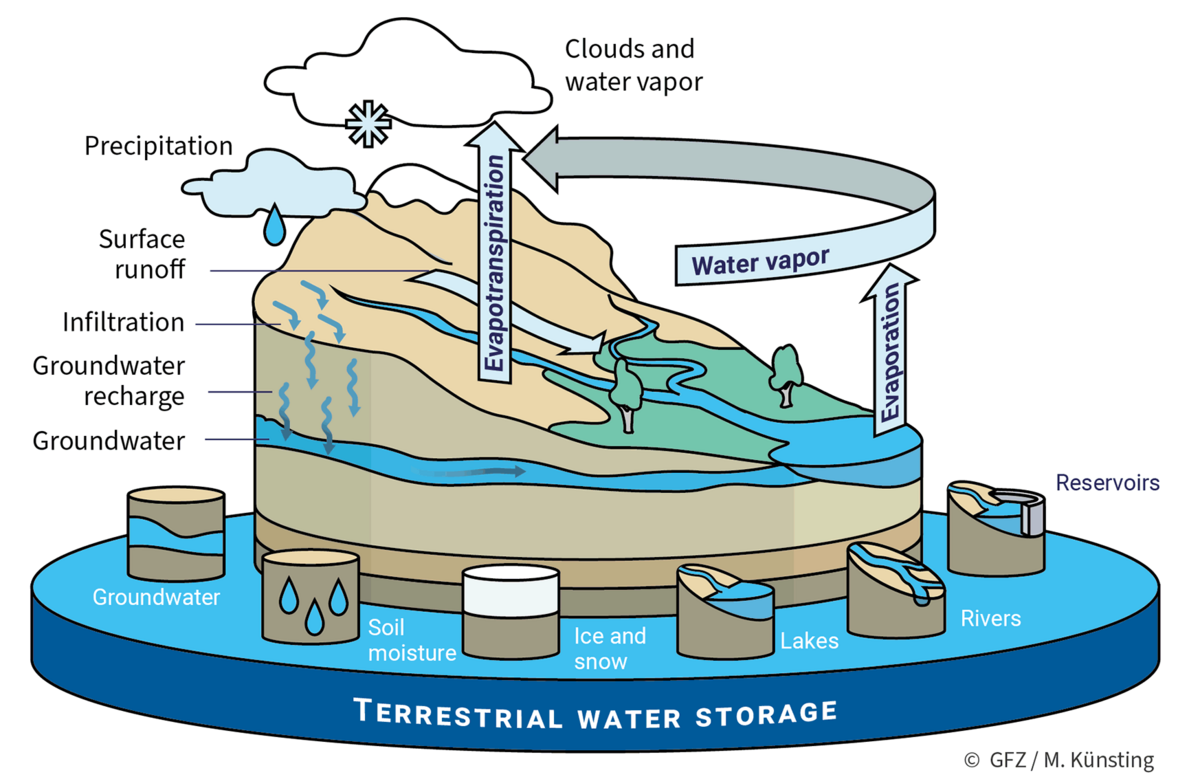Terrestrial water storage
Water storage on the continents is a key variable in the global water cycle. In addition to water storage the continental part of the hydrological cycle is composed of precipitation over land, evaporation (be it from water surfaces, by vegetation and even from industrial facilities or power plants), and surface and subsurface runoff back into the ocean.
In this context, water storage is a state variable of the hydrologic cycle that encompasses different compartments on the continents. Water is stored in many different locations on and below the surface with varying volumes and residence times. These include
- snow cover,
- ice in glaciers, ice caps, or permafrost,
- water storage in surface waters such as lakes, wetlands, and rivers,
- the amount of water stored in vegetation,
- soil moisture, and
- groundwater.
All these storage compartments taken together form total water storage (or terrestrial water storage - TWS). Since temporal changes in terrestrial water storage correspond directly to mass changes, these can be observed with GRACE and GRACE-FO.
What does terrestrial water storage mean?
Terrestrial water storage is of particular importance for understanding the global water cycle. It gives an overall balance of the water fluxes in precipitation, evaporation and runoff. Changes in water storage therefore show how a wide variety of processes have an impact on the distribution of water, for example by seasonal change, climate change, land use change and human consumption, and how this affects the water cycle and ultimately water availability. GRACE and GRACE-FO can for example be used to measure the natural seasonal change in water storage. In the temperate climate region of Central Europe, one can observe an increase in water storage in winter through higher precipitation and lower evaporation rates and a depletion of water storage in summer due to evaporation rates exceeding precipitation. In contrast to this, tropical regions show a seasonal maximum of water storage which is linked to the high precipitation amounts during the monsoon season and a minimum during the annual dry season. Such seasonal variations in water storage are the dominant signal in GRACE/GRACE-FO observations across continents in many regions worldwide.
Using the GRACE satellites to record long-term effects of extreme weather
GRACE and GRACE-FO can also help to observe and quantify long-term changes in water storage and the effects of extreme weather events on the water balance. For example, the higher air temperatures caused by climate change lead to the melting of ice and thus to a decrease in water storage in these regions. The loss of ice mass on the Greenland ice sheet is by far the strongest observable signal. But glacier retreat in glaciated mountain regions worldwide (e.g. Alaska, Patagonia, Central Asia) can only be seen in the long-term negative trends in the data. Other negative long-term trends can also be seen in regions with unsustainable groundwater use (compare article Groundwater). Effects of multi-annual and interannual variations in weather conditions can also be made visible. In many regions of the world periods with below-average precipitation amounts and often simultaneously higher air temperatures stand out as phases with strong negative anomalies in water storage, which are often accompanied by drought conditions. On the other hand GRACE and GRACE-FO also record maxima in water storage e.g. occurring after long periods of heavy rainfall and the large-scale flood events that follow. Since GRACE and GRACE-FO measure changes in total water storage the data show different temporal dynamics than data from near-surface soil moisture measurements. For example, GRACE and GRACE-FO can capture the longer-term effects of a heavy precipitation event that impacts deeper soil layers or groundwater much later than the near-surface soil layers or they can show persisting water deficits in larger depth long after a drought period has passed.
The net effect of the temporal changes in total water storage measured with GRACE and GRACE-FO over the entire continental surfaces is directly linked to the variations in sea level (see contribution Sea Level). Any decrease or increase in TWS in total over all continental surfaces leads directly to a corresponding increase or decrease in sea level. (The capacity of the atmosphere to store water over a longer period is very low, so it cannot serve as a buffer between land and sea).
Because of the fundamental importance of terrestrial water storage to the global hydrological cycle and its sensitivity to the influence of climate change on the hydrological cycle, TWS has been defined as an Essential ClimateIn contrast to weather, which refers to daily or very short-term events, climate refers to an average condition in the atmosphere over a longer period of 30 to 40 years. All processes such as average temperature, precipitation, wind direction, wind s... Variable (ECV) by the Global ClimateIn contrast to weather, which refers to daily or very short-term events, climate refers to an average condition in the atmosphere over a longer period of 30 to 40 years. All processes such as average temperature, precipitation, wind direction, wind s... Observing System (GCOS), which is supported by the World Meteorological Organization (WMO) and other organizations. ECV's are physical, chemical or biological state variables of the Earth’s systems that are suited to characterize the Earth's climate and its changes. For the current 54 ECV's, GCOS regularly assesses the state of global observing systems and develops guidelines for their improvement. GRACE and GRACE-FO form the basis for providing a freely accessible climate data set for TWS that complies with GCOS recommendations.
Text: Prof. Dr. Andreas Güntner, GFZ
Further Information
- Article: GFZ-Journal (1/2023) Ein Wasserzähler im Weltraum (PDF in German)
- Maps and data on GravIS GFZ
- Fact Sheet Terrestrial water storage and groundwater (PDF in German)

